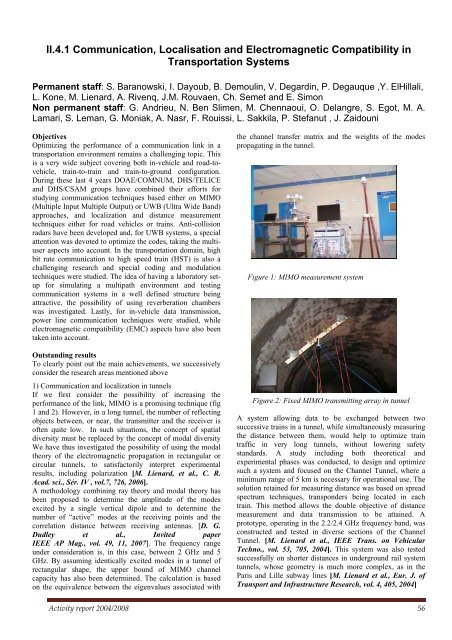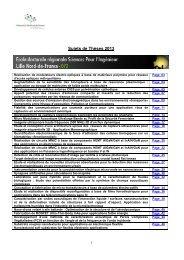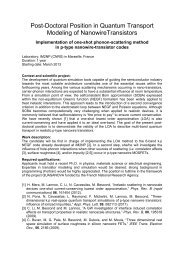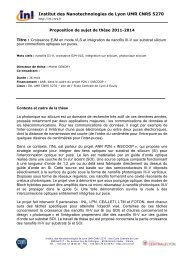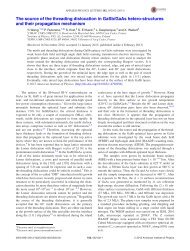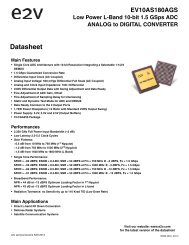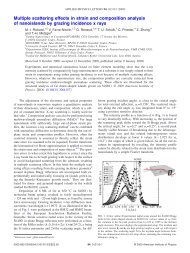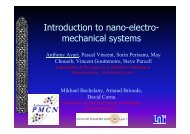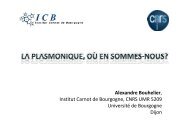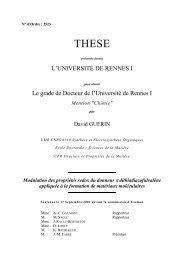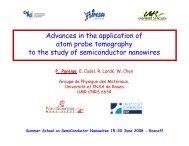Activity Report 2004-2008 (3,5 MB â 1st - IEMN
Activity Report 2004-2008 (3,5 MB â 1st - IEMN
Activity Report 2004-2008 (3,5 MB â 1st - IEMN
- No tags were found...
You also want an ePaper? Increase the reach of your titles
YUMPU automatically turns print PDFs into web optimized ePapers that Google loves.
II.4.1 Communication, Localisation and Electromagnetic Compatibility inTransportation SystemsPermanent staff: S. Baranowski, I. Dayoub, B. Demoulin, V. Degardin, P. Degauque ,Y. ElHillali,L. Kone, M. Lienard, A. Rivenq, J.M. Rouvaen, Ch. Semet and E. SimonNon permanent staff: G. Andrieu, N. Ben Slimen, M. Chennaoui, O. Delangre, S. Egot, M. A.Lamari, S. Leman, G. Moniak, A. Nasr, F. Rouissi, L. Sakkila, P. Stefanut , J. ZaidouniObjectivesOptimizing the performance of a communication link in atransportation environment remains a challenging topic. Thisis a very wide subject covering both in-vehicle and road-tovehicle,train-to-train and train-to-ground configuration.During these last 4 years DOAE/COMNUM, DHS/TELICEand DHS/CSAM groups have combined their efforts forstudying communication techniques based either on MIMO(Multiple Input Multiple Output) or UWB (Ultra Wide Band)approaches, and localization and distance measurementtechniques either for road vehicles or trains. Anti-collisionradars have been developed and, for UWB systems, a specialattention was devoted to optimize the codes, taking the multiuseraspects into account. In the transportation domain, highbit rate communication to high speed train (HST) is also achallenging research and special coding and modulationtechniques were studied. The idea of having a laboratory setupfor simulating a multipath environment and testingcommunication systems in a well defined structure beingattractive, the possibility of using reverberation chamberswas investigated. Lastly, for in-vehicle data transmission,power line communication techniques were studied, whileelectromagnetic compatibility (EMC) aspects have also beentaken into account.Outstanding resultsTo clearly point out the main achievements, we successivelyconsider the research areas mentioned above1) Communication and localization in tunnelsIf we first consider the possibility of increasing theperformance of the link, MIMO is a promising technique (fig1 and 2). However, in a long tunnel, the number of reflectingobjects between, or near, the transmitter and the receiver isoften quite low. In such situations, the concept of spatialdiversity must be replaced by the concept of modal diversityWe have thus investigated the possibility of using the modaltheory of the electromagnetic propagation in rectangular orcircular tunnels, to satisfactorily interpret experimentalresults, including polarization [M. Lienard, et al., C. R.Acad. sci., Sér. IV , vol.7, 726, 2006].A methodology combining ray theory and modal theory hasbeen proposed to determine the amplitude of the modesexcited by a single vertical dipole and to determine thenumber of “active” modes at the receiving points and thecorrelation distance between receiving antennas. [D. G.Dudley et al., Invited paperIEEE AP Mag., vol. 49, 11, 2007]. The frequency rangeunder consideration is, in this case, between 2 GHz and 5GHz. By assuming identically excited modes in a tunnel ofrectangular shape, the upper bound of MIMO channelcapacity has also been determined. The calculation is basedon the equivalence between the eigenvalues associated withthe channel transfer matrix and the weights of the modespropagating in the tunnel.Figure 1: MIMO measurement systemFigure 2: Fixed MIMO transmitting array in tunnelA system allowing data to be exchanged between twosuccessive trains in a tunnel, while simultaneously measuringthe distance between them, would help to optimize traintraffic in very long tunnels, without lowering safetystandards. A study including both theoretical andexperimental phases was conducted, to design and optimizesuch a system and focused on the Channel Tunnel, where aminimum range of 5 km is necessary for operational use. Thesolution retained for measuring distance was based on spreadspectrum techniques, transponders being located in eachtrain. This method allows the double objective of distancemeasurement and data transmission to be attained. Aprototype, operating in the 2.2/2.4 GHz frequency band, wasconstructed and tested in diverse sections of the ChannelTunnel. [M. Lienard et al., IEEE Trans. on VehicularTechno., vol. 53, 705, <strong>2004</strong>]. This system was also testedsuccessfully on shorter distances in underground rail systemtunnels, whose geometry is much more complex, as in theParis and Lille subway lines [M. Lienard et al., Eur. J. ofTransport and Infrastructure Research, vol. 4, 405, <strong>2004</strong>]<strong>Activity</strong> report <strong>2004</strong>/<strong>2008</strong> 56


